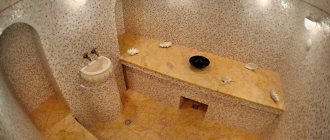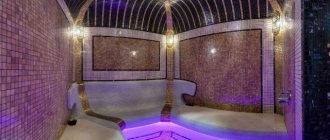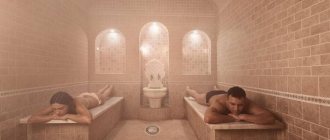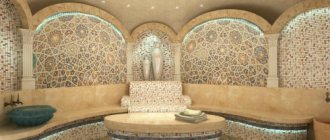Every nation has a tradition that is happily supported in other countries. This happened with the hammam, which came to us from the East and almost immediately gained popularity. What is the difference between a Turkish hammam and a traditional Russian bath? And what should you know when going to a Turkish bath?
Warmth emanating from all sides, natural stone, often mosaics in a traditional oriental style - an environment ideal for relaxation. Due to the comfortable warmth and soft steam, breathing in the hammam is extremely easy; the pleasant microclimate of the Turkish bath is ideal for those who do not enjoy the heat.
A little history
The structure of a traditional hammam
Although exact information about the origin of the hammam has not been preserved, it is believed that such procedures first appeared in the Byzantine Empire. The peoples of the East who communicated with the Byzantines adopted this tradition. However, the use of hot steam in combination with dousing with cold water came a little later. It was believed that visiting the hammam affects the body and mind, female attractiveness and male strength.
The specific architectural style of the hammam was formed by the 12th-13th centuries. Like the Roman baths once upon a time, the hammam became the center of public life. Today there are hammams in almost every town in Turkey; in Europe, Turkish baths began to appear in the 19th century.
Story
But before moving on to the issue of the benefits and harms of procedures, it is worth digging a little deeper into the history of the Turkish bath.
Translated from Turkish, hammam means “spreading steam.” And indeed it is. Steam spreads throughout the room. Moreover, its area is quite large.
According to official documentation, the first mention of the bath appeared over a thousand years ago.
Buildings with hammam inside were built not far from mosques. Thus, Muslims could visit the steam room and perform the ritual of ablution immediately after the temple and prayer.
A little later, the procedures were transformed into social events. People from all over the city came to the eastern bathhouse to exchange news, discuss politics and events in the region, as well as the country.
Women and men steamed separately. One day a week was allocated specifically for the weaker half. The husband could not prevent his wife from visiting the hammam and communicating with her friends. In addition to relaxation and cosmetic procedures, adult ladies in the bathhouse selected wives for their sons.
In the East they are very sensitive to their culture. This is noticeable in the steam room. In most cases, it resembles the hall of a palace. This is a kind of work of art, where each element is selected with taste and does not stand out from the overall concept.
To add luxury to the hall, gilded objects, paintings and other elements are used in decoration.
Unfortunately, the hammam has practically not been preserved in its original form. However, the modern version of the bathhouse also looks luxurious.
What is special about hamam?
There are neither the usual brooms nor a stove, without which not a single Russian-style bathhouse is complete. The steam generated in a special boiler is evenly distributed throughout the room; the high dome-shaped ceiling does not accumulate condensate; it flows down the rounded walls directly into the drainage system. How do the conditions in a hammam differ from the saunas we know or, for example, a Finnish bath? So.
- Temperature . On average, the air warms up to 30-50°C, this temperature regime is more comfortable for a person, moreover, the procedure in such conditions becomes possible for people who either do not tolerate heat well or are undesirable for health reasons. For example, heating in a sauna can reach 100°C or higher; staying at this temperature is contraindicated for patients with various diseases.
- Humidity – reaching 90-100%, it is the highest among those practiced in various types of baths and saunas. At the same time, the body does not experience stress, and there is no risk of drying out the skin and hair. Unlike a Turkish bath, the humidity in a Finnish bath reaches 10-20%.
Warm and maximally humidified air is the secret of a Turkish bath; thanks to the ideal combination of temperature and humidity, a special microclimate is created that has a beneficial effect on health.
Finnish sauna
The Finnish sauna does not have the steam we are used to. Dry air heats up to a temperature of 70-100 degrees, which causes active sweating.
The sauna should be used by people with a strong heart, since it is difficult to breathe in dry hot air, and by people who cannot tolerate high humidity. Her visit is contraindicated for people with hypertension, heart disease and kidney disease. Do not use a broom to avoid burns.
Benefits of the Finnish sauna:
- stress management
- relieving fatigue
- relaxation
- reduction of edema
- vascular training
- boosting immunity
- removal of harmful substances
Doctors believe that the Finnish sauna promotes rapid muscle recovery. Therefore, visiting the sauna is recommended after training and any sports activities.
Visiting rules
Before visiting, you should take a shower without soap and dry yourself. To avoid getting burned, remove jewelry. Don't neglect your hat. There can be a maximum of four entries. The first one is the shortest for the body to adapt (4-5 minutes), the next ones – up to 10-15 minutes, but no more. Between visits, take a cool shower, drink water and herbal teas.
Lose weight with pleasure!
The pace of life, snacks on the go, often not the best quality food, lack of time for sports - and now extra pounds have appeared. Heading to the gym? But intense physical activity, as a rule, does not evoke enthusiasm after a hard day at work. Try the hammam!
It turns out that you can lose a couple of kilograms in one session. During the procedure, metabolism accelerates and fat deposits are broken down. Temperature contrast, intensive soaping and massage also have an anti-cellulite effect.
How to go to the hammam correctly to get rid of extra pounds? Of course, to get the maximum effect, visiting the Turkish bath should be regular and combined with other methods, for example, with the same balanced diet or walking. Otherwise, the lost kilograms will return again.
Sign up for the online course “Basics of nutrition for health and weight loss”
By the way, a good mood after the procedure is not an accident, since staying in the hammam increases the level of hormones responsible for the psycho-emotional state. In addition, the endorphins produced have an antidepressant effect. Agree, such weight loss for a person who is not a sports fan is much more attractive than intense training in the gym.
Turkish bath - what is it?
Eastern culture has its own characteristics and the sauna in this case is no exception. Visiting a steam room of this type is a kind of ritual. If people initially went to the Russian bathhouse solely for the sake of cleansing, and only now it has become a kind of ritual and an opportunity to have a good time in a pleasant company, then visitors initially came to the hammam to spend time and communicate with other people. The procedures themselves faded into the background.
However, they are no less pleasant than any other and can significantly improve a person’s health, as well as improve his appearance.
Benefit for health
It turns out that hammam is an affordable way to improve your health. Under the influence of hot steam, the heart rate increases, blood vessels dilate, blood circulation increases, which more intensively delivers much-needed oxygen to tissues, including to the periphery.
When immersed in a pool or Jacuzzi with cooler water at the final stage, due to the temperature contrast, a kind of training of thermal adaptation mechanisms in the body occurs, and blood pressure normalizes. Regular visits to the hammam improve the ability to adapt to any weather conditions; in the future, the human body can easily cope with overheating or hypothermia.
In addition, when skin receptors are irritated, the nervous system is stimulated. A visit to the hammam is ideal for relaxation, apathy and irritability disappear, the quality of sleep improves, headaches and feelings of fatigue go away.
What to do if colds have become the norm in your life? A sharp change in temperature triggers the body's defenses, and a person is able to resist colds. Moreover, under the influence of temperature and humidity, the blood supply to the mucous membrane of the respiratory tract increases, a bronchodilator effect is noted, sputum discharge and gas exchange improve. The breathing rate may increase, which affects the volume of the lungs, and their ventilation improves.
Is it possible to go to the hammam if you have a cold, because one of the contraindications to the procedure is the acute form of any disease. Discomfort and sore throat become less pronounced, hot and humid air reduces swelling of the mucous membrane. However, if the temperature rises and the condition worsens, it is better to postpone visiting the bathhouse.
The healing properties of hamam
The healing properties of hamam have been known since ancient times. The great Arab physician, scientist and naturalist, poet and encyclopedist Avicenna (Ibn Sina) considered the bathhouse one of the most powerful means of healing and treatment.
The work of this scientist, “The Canon of Medical Science,” contains a lot of information that is not outdated to this day. A number of recipes and prescriptions are used in modern medicine. Avicenna argued: “If you exercise, lead a healthy lifestyle and don’t forget to go to the bathhouse, there is no need for medicine.” He pointed out the beneficial effects of hammam on blood circulation, breathing, and the ability to lose excess weight. Avicenna recommended a bath for insomnia, paralysis, and nervous disorders. In his opinion, it is indispensable for catarrh of the upper respiratory tract and inflammation of the vocal cords. The bath also helps with gastrointestinal diseases: diarrhea, loss of appetite, indigestion. Dry steam is useful for treating rheumatism. The list of diseases for the treatment of which Avicenna recommends bathing procedures is endless: jaundice and liver swelling, pain in the bladder, kidney stones, pain in the spleen... The scientist also points out contraindications for visiting the hammam: epilepsy, liver blockage, headaches, noise and ringing in the ears. He warns against drinking cold water after a bath and warns that the bath is harmful to vision.
Improved appearance is another plus of the procedure
Photo of the Red Lake Detox Clinic
Warmth, humidity, and temperature contrast improve the trophism of the skin, affect microcirculation, and stimulate its protective, metabolic, and regenerative functions. Under the influence of heat, the pores on the skin expand; during procedures (cleansing and peeling), the skin is cleansed, moisturized and tightened, the functioning of the sebaceous glands is normalized, and acne disappears. Improving metabolic processes promotes rejuvenation, the skin becomes soft and elastic.
By the way, unlike other types of baths, in the hammam the hair is not at risk of drying out, which is important if it is brittle and dry. Moreover, soft steam normalizes blood circulation in the scalp, stimulating hair growth and improving its appearance.
Hammam: visiting rules
Photo from the website golden-hammam.ua
To get only pleasant emotions and maximum health benefits from visiting a hamam, you need to know how to go to a Turkish bath correctly: how to steam in a chebek, use peelings or cosmetics, and how long you need to stay in the harare.
First of all, before starting various massage procedures, you should sweat thoroughly. To do this, lie down or sit on a lounger for 20-30 minutes, which is previously covered with a cloth. The body is steamed, and all the pores are opened, so after about 30 minutes you need to start various types of massage. In a real Turkish bath he is quite energetic and sometimes even tough. Strong movements accelerate the blood, rub the whole body, which allows you to restore flexibility to the joints and stretch the muscles well.
Photo from the site m.slovenskenovice.si
After such manual therapy, you can lie down and relax for a while, or you can do peeling. To do this, use a hard glove to cleanse all dead and keratinized particles from the skin. The stage following peeling is a light soap massage. A bar of regular soap is placed in a mesh bag and shaken a little, resulting in a thick and soft foam. They cover the visitor from head to toe, and then begin to massage. After this, you can go to the relaxation room - there everyone will be offered to relax and drink a cup of herbal tea.
When visiting a hammam, you need to remember that, unlike Russian and Finnish saunas, in such a Turkish bath, as a rule, there is no pool, since the Turks consider standing water unclean. Instead, there are several fountains in the steam room.
It is important to follow these recommendations:
- While visiting the hammam, it is prohibited to drink any alcohol or drink very cold drinks.
- It is better to limit yourself to tea, diluted juices, plain or rose water.
- There is no need to overeat before the bath. Ideally, more than 2 hours should pass after the last meal.
- Never make sudden movements in the steam room. This can be bad for warm muscles, as they are easily damaged in this state.
- It is not customary to go without clothes in such a bathhouse.
What are the benefits of hammam for sports lovers?
People who are actively involved in sports have often experienced discomfort after training associated with excessive stress. To alleviate the condition, you can go to a Turkish bath. In combination with a massage, you can warm up and stretch your muscles, relieving pain. In addition, overstrained muscle tissue interferes with normal blood circulation, which leads to insufficient oxygen supply. Under the influence of heat, all processes are activated, tissues become more elastic, painful sensations recede.
In addition, you can go to the hammam with diseases of the musculoskeletal system; the microclimate has a beneficial effect on tissue trophism, activating restoration processes in bone and muscle tissue, and the condition of spasms and contractures improves.
The benefits of hamam
The beneficial properties of hamam procedures have made it one of the most popular. Regular visits to the Turkish sauna will help achieve the following effects:
- remove salt deposits;
- normalize blood pressure;
- increase immunity;
- relieve muscle tension;
- cure some respiratory diseases.
The benefits of Turkish hammam for the body are based on the removal of toxins, relaxation of the body and soul.
For women's health
Most women spend a lot of time on their own appearance. The procedures offered by the hammam staff have a number of advantages: they will help preserve beauty, get rid of cellulite, improve skin condition, and strengthen hair. Healthy sleep and stress relief will be an addition after visiting the hammam.
For men's health
The beneficial properties of hammam have been proven for the male body. Since it is the stronger sex that is most susceptible to various diseases associated with the functioning of the genitourinary system, it is useful for men to visit the hammam. With increased sweating, the kidneys are unloaded for a certain time, which relieves pain. Men visiting a Turkish sauna relieve nervous tension that occurs during stress and normalize the general condition of the body.
For athletes
After a workout, the hammam allows you to relax your joints and muscles, and relieve stress that occurs during strength training. The benefits of visiting the hammam after the gym are manifested in the relief of painful sensations, which allows you to reduce breaks between workouts. However, you should not do this, because the process of muscle and tendon restoration proceeds as usual, and the felt relaxation in the hammam does not speed it up.
To relax your back muscles after training, it is recommended to steam while sitting. Lying down can cause irreparable harm to your body: one awkward movement can lead to a dislocation of the spine.
Hygiene procedure? Relaxation? Pleasure!
And although hammams have not survived to this day in their original form, there are Turkish baths created taking into account ancient traditions. But in order to get maximum pleasure and benefit, you should follow a clear sequence of actions when visiting. Staying in the hammam is a whole ritual, consisting of five procedures in a certain sequence: warming up the body, massage, peeling, soaping and pouring, relaxation.
- To prepare for the procedures, there is a special room - jamekian - where the visitor leaves his clothes and shoes, dressed in a sarong or a sheet.
- Pestemal is a room where a person takes a warm shower for 15 minutes (approximately), which is necessary to cleanse the skin and prepare for further procedures.
- Chebek – here the body is prepared; for this purpose there is a special bed made of natural marble, on which the visitor sits.
- Hararet is a spacious marble room with a round shape, designed for deep cleansing of the skin. First, a steaming procedure is carried out, during which the pores of the skin open, followed by intensive soaping and rubbing using a goat hair washcloth - at this time, high-quality peeling of the skin occurs. When rinsing, warm and cool water are used alternately. The final stage is a soap massage.
- To recuperate after exposure to high temperatures, the visitor moves to the next room, where the temperature is lower than in other rooms. There are showers here, where you can lie down and enjoy aromatic tea.
- Finally, you should visit the steam room again, where an oriental master will give you a massage.
- After the session, you can swim in pools with water of different temperatures; in the classic version of the bath there are three pools: with a temperature of 45°C, similar to body temperature, room temperature.
After passing through all the rooms, the body, according to legend, is cleansed. Unfortunately, traditional baths are being built less and less often, since it is not always possible to find a place of suitable size. Therefore, in modern hammams there are often only three rooms intended for preparing, steaming and cooling the body.
What is the difference between a hammam and a sauna and a Russian bath?
The Turkish hammam is qualitatively different from the usual Russian bathhouse and Finnish sauna. For clarity, you can consider the features of the hammam in comparison with them.
| Index | Hammam | Finnish sauna | Russian bath |
| Temperature | 40-600С | 90-1200С | 50-700С |
| Humidity | 100% | 5-10% | 60-80% |
| Steam creation method | Steam generator | In a stove-heater, pouring water over hot stones | |
| Finishing | Marble and stone | Wood, tiles | tree |
| Traditional procedures | Massage using oils | Body massage with a birch broom | |
As you can see, there are many differences between the Turkish hammam and the Finnish and Russian baths. Thanks to the low temperature conditions, people who cannot withstand high temperatures go there. The difference in the finishing of the Turkish sauna can be seen in the photo below.
How to go to the hammam
There are several rules that must be followed when visiting a Turkish bath.
- Before the procedure, avoid alcohol, fatty and fried foods; This way you can avoid unnecessary stress on the body.
- A sarong or a sheet made of natural fabrics is intended for the procedures
- Before you lie down on the massage bench, you need to lay a towel.
- There are separate rooms or hours for ablutions for men and women.
What should you take with you when going to the hammam? All you need are bath shoes, two towels - for the body and to cover the bench, and a sarong. However, all this can be obtained in the bathhouse.
How often can you go to the hammam? And if every day, won’t the load on the body be unnecessary? A person should be guided by his feelings and state of health. To maintain tone, visits can be weekly. For colds, frequent stressful situations, insomnia, etc. the procedure can be performed more often. If you play sports, then it is right to go to the hammam after training in a fitness club or gym. In this case, you should wait until your pulse, breathing and blood pressure return to normal.
And if you go to the hammam often, how much time can you spend there without harming your health? If staying in a room with high temperature and humidity does not cause discomfort, then bath procedures should be given at least one and a half hours. However, visiting a hammam in the East has always been considered a source of pleasure, going beyond the scope of a hygienic procedure. For example, eastern women could spend the whole day there, and most of the time was devoted to communication and tea drinking.
What is a real hammam?
A real Turkish bath is the wettest and lowest temperature of all baths existing in the world. In eastern countries, a hammam is a building that necessarily has a changing room, a dressing room, a steam room, a washing room, a massage room, a relaxation room and a swimming pool with running water. There, visitors move from a room with a lower temperature to a room with a higher one, and after the steam room, they first swim in a pool with hot water, and then only in water with a lower temperature. That is, the body does not experience any stress.
In a Turkish bath, special attention is paid to the interior and equipment. The domed ceiling serves to ensure that drops do not fall on vacationers, but roll down the walls onto the floor and evaporate. Stone mosaic or marble evenly absorbs and releases heat. Steam and hot water from boilers located under the floor or in the walls passes through pipes under the floor and seats and heats them, and the steam enters the room through small holes. Thus, everything in the hammam is evenly heated: walls, floor, sun loungers.
Contraindications
As with any healing method, there are a number of contraindications for visiting a bathhouse that must be taken into account when choosing a healing method. Hama is contraindicated if there is:
- increased temperature, high or low blood pressure;
- exacerbation of a chronic disease;
- presence of cancer;
- mental disorders, epilepsy;
- infectious and fungal diseases;
- severe diseases of the cardiovascular, respiratory, urinary systems;
- bleeding and open wounds.
The session is also contraindicated on an empty stomach or immediately after eating. As for pregnancy, you can go to the hammam starting from the second trimester. However, at any time it is better to refuse to stay in the steam room. In addition, women often have a question: is it possible to go to the hammam during menstruation? In this case, you should postpone visiting the bathhouse, since staying in the steam room can provoke increased bleeding, and pressure changes are also possible.
Turkish hammam
This is a completely different type of bathhouse. Firstly, it is a stone building. Secondly, heat is supplied from below, from under the floor. A traditional hammam involves a stay of up to 1.5 hours, necessarily ending with a massage session. Corridors branch off from the central room into steam rooms with different temperatures. The essence of the process is to gradually move from a cooler room to a slightly warmer one. Next, visitors are escorted to the soap room. There they lie down on a high marble table, where bathhouse attendants use special mittens to exfoliate them and then foam massage them. After a dip in the refreshing pool, you'll be taken to the relaxation room, where you can relax on a daybed, sip a cup of tea and prepare for the final step of your spa treatment - a massage with special essential oils.
The Turkish bath is considered soft; the temperature here does not rise above 50 ⁰C. Therefore, hammam is often recommended to beginners.
Where can I find a hammam?
Today you don’t have to go to Turkey to go to the hammam; fitness clubs, spas, health centers, and sanatoriums offer this service. Of course, the choice of materials and approach to the construction of premises is much simplified, although the interior decoration is still done in an oriental style. However, the fullness of sensations, as a rule, remains high.
Moreover, today a small-sized Turkish bath can be equipped in a house or even an apartment; it is enough to purchase a steam box equipped with a steam generator, which is controlled by an electronic control system. Despite the simplified design, steam, as a rule, is produced of high quality, while energy costs are well within the limits of household electrical wiring.
However, for connoisseurs of Turkish baths, the hammam is not just a place for hygiene procedures. This is a wonderful opportunity to relax, relax and meet friends. Therefore, when going to the hammam, choose a time that you can fully devote to pleasure without compromising unfinished business. It is impossible to get the maximum benefit for the body or pleasure if your stay in the hammam is accompanied by a rush. In the end, you can just wash yourself at home, but that’s not the main thing for us!
Oksana Matiash, general practitioner
What is a hammam: differences from a traditional bath
Hamam is the name given to public baths in the Middle East (Turkey, Azerbaijan, Iran, Afghanistan and some countries of Central Asia). These peoples have been developing the Eastern tradition of visiting the Turkish hammam for centuries. The benefits of visiting such establishments in Russia are questioned. Often local entrepreneurs offer only a name from a traditional Turkish bath.
There are several features of a real Turkish hammam:
- Temperature from 35 to 50 degrees.
- Air humidity 90-100%.
Despite the fact that you can learn the technique of the original Turkish bath in any Turkish village, Russian entrepreneurs do everything at random, endangering the health of visitors. A real Turkish hammam has benefits for the body only if traditional indicators are adhered to: 100% air humidity at a temperature range of 35 to 50 degrees. Thanks to these parameters, a unique microclimate is created that allows you to visit the hammam with benefit and safety.
The Arab writer Yusuf Abdalhadi said: “Whoever has committed many sins, let him build a bathhouse to wash them away.”
Roman bath
One of the most ancient types of baths. In fact, the baths are prototypes of Turkish hammams. These are also stone buildings with central heating and heated floors and walls. The modern Roman bath is distinguished by marble-clad rooms with heated marble loungers. The thermal bath was divided into separate rooms that had to be visited sequentially. They were called: caldarium, tepidarium, frigidarium.
The modern caldarium is a room decorated with ceramic tiles, heated floors and a large bathtub with water. Humidity in the caldarium is kept at 80-100%, temperature 37-45 ⁰C. The room is usually filled with the aromas of essential oils of healthy herbs and plants. Great importance is attached to design; caldariums are usually decorated in warm colors, with picturesque paintings from the life of Ancient Rome placed on the walls.
Tepidarium is a room with dry warm air. The temperature here, just like in the caldarium, is maintained at 37-45 ⁰C, but the humidity is much lower, only 30%. The tepidarium is equipped with marble beds and armchairs. Heating, as in all rooms of the Roman baths, is carried out from below. The tepidarium is comfortable for a fairly long stay. After visiting it, the body will require replenishment of moisture.
Frigidarium is a cool room with a swimming pool, where you go after visiting the tepidarium and caldarium to refresh and relax.











